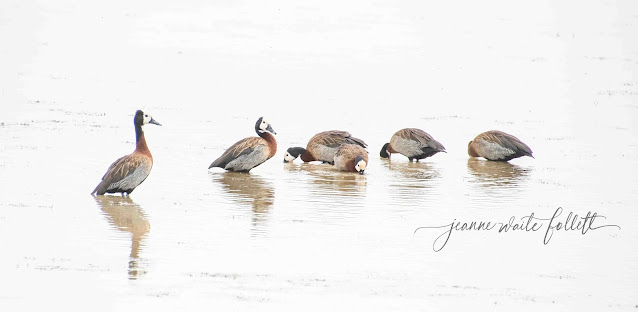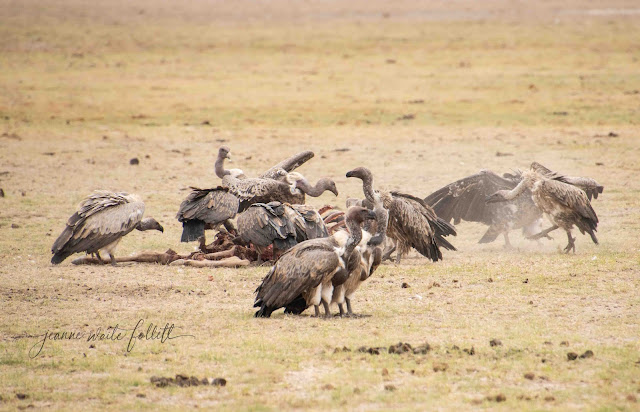Chapter 4:
First Look at Amboseli NP
“Amboseli” -The Salty Dust
-Maasai word
It is still early morning when we approach the landing strip at Amboseli National Park. As we descend, we catch glimpses through the cloudy overcast of Mt. Kilimanjaro, a dormant volcano that is the highest mountain in Africa. At 19,342 feet, it is one of the Seven Summits sought by mountain climbers.
 |
| Kili, as it is locally known. Obviously I took the photo after landing. |
 |
| The airstrip terminal |
Wildebeest, impalas, and zebra surround the dirt strip. We land and are greeted by the men who will take us to our first safari camp, Tawi Lodge, located in a private conservancy outside the park limits. It advertises stunning views of Kili, as the mountain is casually called.
I look at the overcast and am glad it isn’t raining, like it was in Nairobi when we departed. Little did I know that I would soon be hoping for rain. Lots of rain. Weeks and weeks of rain.
Our baggage, with special care taken for the camera bags, is loaded and we climb in the Land Cruisers. We are told that it is a “long way” to camp. Ah, well, it’s a little after 8A.M., the light is moderately good, and we all have at least one camera at the ready.
 |
| The long towers on this Cape Buffalo's horns are fecal towers made by horn moths. |
Randy and I are riding with Joseph.
We are greeted by a zebra, or “ZHEB-rah” as Africans call them.
Joseph spots some lions far out on the barren plains, much too far for photos. A short distance farther, we stop at a spotted hyena den that is immediately beside the road. Some pups are out of their underground dens and we photograph them for a while.
 |
| The dark hyenas are pups. They will acquire the typical hyena coloring as they mature. |
Suddenly, a lion approaches the den vicinity and something remarkable happens. The pups scurry underground as four adults line up in a row and confront the lion. Nothing physical occurs between the deadly enemies. The lion acts like he’s the king, the hyenas act like they’re boss.
 |
| Confronting the lion. |
The confrontation. Click on the > to play the video.
The lion wanders around and lies down.
The hyenas return to the den, satisfied that they have dissuaded the lion from coming closer.
 |
| Note the lion at upper left. Just a dot on the savannah. |
 |
| The bone field around the hyena den looks like a charnel ground.. |
When we drive a little farther, we see vultures all over a carcass, and this sight becomes the iconic scene for Amboseli. Animals are dying by the hundreds. There has not been enough rain in several years to make the all-important grasses grow.
 |
| A tawny eagle waits its chance. |
There is water to drink, but food is scarce and the animals are dying of starvation. The wildebeest seem to be hit the hardest, but zebra and other grazing/browsing animals are suffering, too. Even the elephants, for which Amboseli is famous, are withering away.
We are lakeside, now, and the creatures that depend on water and the things that live in water, are flourishing. It is a bird photographer's heaven and I take full advantage.
 |
| White-faced whistling ducks. |
 |
| Blacksmith lapwing |
 |
| Black-winged stilt. |
 |
| Gray heron with a small fish in its bill. |
 |
| Squacco heron |
 |
| Another look at the squacco heron. Note the long toes that enable it to walk on lily pads and other vegetation. |
 |
| A starving wildebeest. Note the lack of musculature in the hind quarters and the visible hip bones. |
 |
| A vervet sits alongside the water. |
 |
| A wildebeest crosses the road, searching for greener pastures. Photo taken through the windshield. |
 |
| A pair of Egyptian geese. |
 |
| A gray heron next to the Amboseli lodge. The lodge was closed several years ago due to flooding. |
 |
| Gray heron. |




















Another great and interesting post Gullible. It sure is nice to see you cranking them out. Smiles from Cap and Patti
ReplyDelete